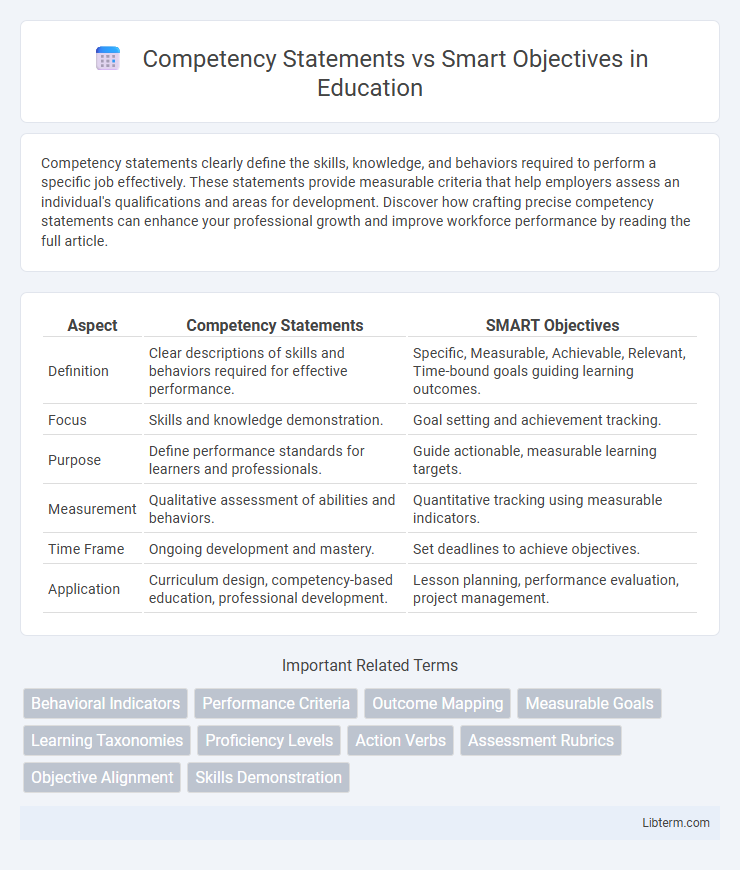Competency statements clearly define the skills, knowledge, and behaviors required to perform a specific job effectively. These statements provide measurable criteria that help employers assess an individual's qualifications and areas for development. Discover how crafting precise competency statements can enhance your professional growth and improve workforce performance by reading the full article.
Table of Comparison
| Aspect | Competency Statements | SMART Objectives |
|---|---|---|
| Definition | Clear descriptions of skills and behaviors required for effective performance. | Specific, Measurable, Achievable, Relevant, Time-bound goals guiding learning outcomes. |
| Focus | Skills and knowledge demonstration. | Goal setting and achievement tracking. |
| Purpose | Define performance standards for learners and professionals. | Guide actionable, measurable learning targets. |
| Measurement | Qualitative assessment of abilities and behaviors. | Quantitative tracking using measurable indicators. |
| Time Frame | Ongoing development and mastery. | Set deadlines to achieve objectives. |
| Application | Curriculum design, competency-based education, professional development. | Lesson planning, performance evaluation, project management. |
Understanding Competency Statements
Competency statements define specific skills, behaviors, and attributes required for effective job performance, serving as measurable criteria for employee evaluation. These statements help organizations identify skill gaps and tailor professional development initiatives. Understanding competency statements is essential for aligning employee capabilities with business goals and enhancing overall workforce performance.
Defining SMART Objectives
Defining SMART objectives involves creating Specific, Measurable, Achievable, Relevant, and Time-bound goals that guide clear performance expectations. SMART objectives provide quantifiable benchmarks and deadlines, enhancing focus and accountability compared to broader competency statements. This structured approach ensures actionable results aligned with organizational priorities and individual development.
Key Differences Between Competency Statements and SMART Objectives
Competency statements define the skills, behaviors, and attributes required for effective job performance, focusing on qualitative, measurable traits that guide employee development. SMART objectives are specific, measurable, achievable, relevant, and time-bound goals designed to drive performance outcomes with clear targets and deadlines. Key differences lie in competency statements emphasizing ongoing capabilities and personal growth, whereas SMART objectives concentrate on concrete, deadline-oriented achievements.
Purpose and Applications in the Workplace
Competency statements define the essential skills, behaviors, and knowledge required for effective job performance, serving as a framework for employee development and performance evaluation. SMART objectives provide specific, measurable, achievable, relevant, and time-bound goals that guide individual and team performance toward organizational targets. In the workplace, competency statements facilitate talent management and career pathing, while SMART objectives drive focused task accomplishment and continuous improvement.
Structure and Components Comparison
Competency statements focus on describing specific skills, behaviors, and attributes required for effective job performance, emphasizing observable actions and underlying qualities. Smart objectives are structured around Specific, Measurable, Achievable, Relevant, and Time-bound criteria designed to set clear, actionable goals with quantifiable outcomes. Competency statements highlight capabilities and proficiency levels, while Smart objectives prioritize goal orientation with defined measurement and deadlines to track progress.
Measuring Performance: Competencies vs. Objectives
Competency statements measure performance by evaluating an individual's skills, behaviors, and qualities that contribute to job effectiveness, often assessed through qualitative metrics and ongoing observations. Smart objectives focus on specific, measurable outcomes with clear deadlines, using quantitative data to track progress and results. While competencies capture how work is performed, smart objectives emphasize what is achieved, enabling precise performance measurement and accountability.
Aligning Competencies with Organizational Goals
Aligning competencies with organizational goals requires integrating competency statements that define essential skills and behaviors directly linked to strategic priorities. Smart objectives provide specific, measurable targets that operationalize these competencies, ensuring progress can be tracked and evaluated against key performance indicators. This alignment fosters a cohesive framework where employee development supports overarching business outcomes, driving improved performance and goal attainment.
When to Use Competency Statements vs. SMART Objectives
Competency statements are best used during performance evaluations and professional development to assess specific skills, behaviors, and knowledge required for job roles. SMART objectives are ideal for goal-setting scenarios where measurable, time-bound, achievable targets need to be clearly defined and tracked. Use competency statements to evaluate overall capabilities and SMART objectives to drive focused actions and outcomes within a set timeframe.
Common Mistakes in Writing Competencies and Objectives
Common mistakes in writing competency statements include vague language, lack of measurable criteria, and failure to align with job roles. Smart objectives often suffer from being either too broad or overly rigid, missing the balance between specificity and flexibility. Both require clarity, relevance, and measurable elements to effectively guide performance and development.
Best Practices for Integrating Both Approaches
Integrating competency statements with SMART objectives enhances employee development by clearly defining skills and setting measurable performance goals, ensuring alignment with organizational strategy. Best practices include mapping competencies to specific, time-bound objectives that facilitate continuous feedback and performance tracking while promoting skill mastery. Combining both approaches fosters a comprehensive framework for talent management, optimizing training programs and accelerating career progression.
Competency Statements Infographic

 libterm.com
libterm.com